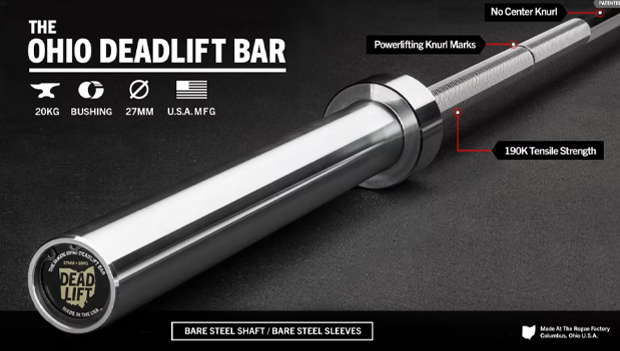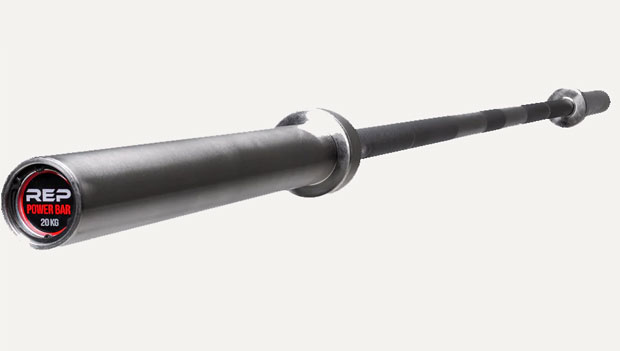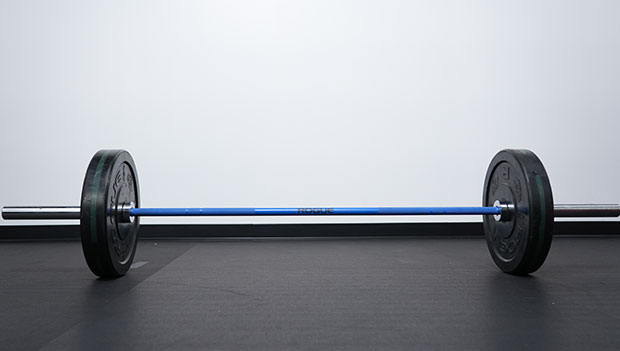
By clicking on the product links in this article, we may receive a commission fee at no cost to you, the reader. Sponsorships and affiliate commissions help support our research so we can help you find the best products. Read our full affiliate disclosure here.
Barbells can be used for a variety of movements to train strength—like those in powerlifting and Olympic lifting—but when it comes to weightlifting, does the type of barbell you use matter? Think of it this way; you wouldn't use a pair of deadlift shoes to train for a marathon, so choose a barbell best suited for the lifting you plan to do. The great debate of using a stiff bar vs. a deadlift bar really comes down to looking at the subtle differences between them and how they benefit your fitness goals.
In this comparison, we'll be taking a closer look at the deadlift bar and stiff bar, along with high-quality bar options like the Rogue Ohio Bar, among others. That way, when deciding between a deadlift and a stiff bar, you can choose which option works best for your gym.
Why Trust Us?
The health and safety of ACTIVE's readers is of the utmost importance to us. To ensure your well-being when consuming protein powders, the ACTIVE.com editorial team prioritizes products that are independently tested by a third-party. We've also consulted with a team of nutritionists and dieticians to ensure the products we feature are of the highest standard. This helps us create the most accurate, authentic review content for our readers. More importantly, fitness may be our job, but it is also our passion. Therefore, we strive to bring you products that we trust and would personally use.
Deadlift Bars vs. Stiff Bars - Our Recommendations
Deadlift Bars
Stiff Bars
Deadlift Bars
There's no secret meaning behind the name; deadlift bars are made for deadlifting. These bars are made to withstand heavy loads and bend slightly near the center. Also referred to as the whip or flex, the bend in the bar allows the lifter to build up more speed and momentum before the weights come off the floor. This extra power can enable you to move more weight and set new personal records while deadlifting.
Aside from a greater whip and the ability to stand heavier loads, a deadlift bar typically has a more aggressive knurling and no center knurl. At 7.5 feet, they're longer than other types of bars, and the shaft diameter is commonly smaller.
Rogue Ohio Deadlift Bar
SPECS
- Weight: 20 kg
- Diameter: 27mm
- Shaft length: 75"
- Total length: 90.5"
- Sleeve length: 15.5"
- Tensile strength: 190,000 PSI
- Center knurl: No
The Rogue Ohio Deadlift Bar has a Cerakote finish known for its rust and abrasion resistance, and it comes in three different color options. While Cerakote is a very durable finish option, you can also choose between stainless steel finish or bare steel, each varying in price. The steel shaft has a tensile strength of 190,000, a thinner diameter, and a longer length to optimize the whip performance.
The sleeves have a snap ring construction, which is high-quality compared to the cheaply produced bolt-and-pin systems seen in other brands. Since this bar is designed for deadlifting, the knurling is deep and aggressive—so you have a solid grip—and there are knurl marks to help guide your hand placement.
What We Like
- Several finish and color options available
- 190,000 tensile strength
- Snap ring construction
- Thinner diameter and aggressive knurl make gripping easy
What We Don't Like
- Finish on sleeves may wear more quickly
- Expensive
Titan Series Deadlift Bar
SPECS
- Weight: 20 kg
- Diameter: 28.5mm
- Shaft length: 55.5"
- Total length: 90.5"
- Sleeve length: 16.25"
- Tensile strength: 200,000 PSI
- Center knurl: No
The Titan Series Deadlift Bar has a black zinc shaft and hard chrome sleeves. The black zinc shaft is coated with Cerakote, which adds an extra layer of protection and durability against the elements. At 28.5 inches, the diameter is a little bigger than the Ohio Bar and has an aggressive diamond textured knurling.
You'll find bronze bushings between the shaft and the sleeve that help provide a smooth, consistent roll. This deadlift bar can handle up to 2,000 pounds of weight and has a higher tensile strength of 200,000. It has the right amount of whip and flex to help you move fluidly through your lift.
What We Like
- Single knurl marks are suitable for conventional, Sumo, and Romanian deadlifts
- 16.25" of loadable sleeve length
- 200,000 tensile strength
- 1-year warranty with a 100% satisfaction guarantee
What We Don't Like
- Shaft diameter may be harder to grip for some
- No other finish and color options available
BUY: Titan Series Deadlift Bar
Stiff Bar
A stiff bar, commonly known as a standard, power, or Olympic barbell, can be used for a range of exercises, from squats to overhead presses. As you could probably guess, they're stiffer than a deadlift bar, meaning you won't have the additional flex or whip. If you want to use this bar to deadlift, you probably won't notice a difference if you lift light to moderate weights. It's really those heavier deadlifts that a bar with more whip is best.
These bars are used for a wider variety of lifts, so you'll find that the knurling is less aggressive and keeps your hands from getting torn up as you clean and press the bar. The shaft is typically longer to accommodate the wider grip needed for snatches. You'll also find that some stiff bars have a center knurling, which helps keep it in place on your back while you squat.
REP Fitness Stainless Steel Power Bar
SPECS
- Weight: 20 kg
- Diameter: 29mm
- Shaft length: 53.6"
- Total length: 87.4"
- Sleeve length: 16.9"
- Tensile strength: 200,000 PSI
- Center knurl: Yes
The REP Fitness Stainless Steel Power Bar has a stainless steel finish, which provides a raw feeling when gripping the bar and also offers the most resistance against oxidation. The medium-depth knurling will keep it from slipping, but it won't tear up your hands like a more aggressive grip. There are also IPF (International Powerlifting Federation) standard knurl markings 32 inches between marks to help you with hand placement.
The snap ring bushings are designed for slower strength-focused lifts, making this stiff barbell an excellent option for deadlifting and other lifts. With a tensile strength of 200,000 and the ability to move up to 1,500 pounds, this bar is strong. Since the sleeves are coated, you'll find it very easy to slide the plates on and off the bar between sets.
What We Like
- Greater shaft diameter for more control
- Coated sleeves make adding and taking weight off easy
- Center knurling helps grip during squats
- Versatile, can be used for other lifts
What We Don't Like
- No other finish options are available
- Expensive
BUY: REP Fitness Stainless Steel Power Bar
Rogue Ohio Power Bar
SPECS
- Weight: 20 kg
- Diameter: 29mm
- Shaft length: 51.5"
- Total length: 86.52"
- Sleeve length: 16.25"
- Tensile strength: 205,000 PSI
- Center knurl: Yes
The Rogue Ohio Power Bar comes with several different finish options, including black zinc, stainless steel, bare steel, and E-Coat, depending on your training environment and budget. With a tensile strength of 205,000 (200,000 for stainless steel), you'll find that this bar is more rigid and has a reduced whip.
Even though this is a stiff bar, it has an aggressive knurling which is an excellent option if you want to utilize it for deadlifting or if you prefer a deeper knurl. The Ohio bar is also backed by a lifetime warranty against bending, which goes to show that Rogue is confident in the quality of their barbells.
What We Like
- Knurling is deep and not abrasive
- Several finish and color options are available
- Designed for squatting, benching, and deadlifting
- Slightly longer loadable sleeve length
What We Don't Like
- Cheaper finish options more susceptible to corrosion
- Knurling may be too aggressive for some
What is a Deadlift Bar?
A deadlift bar is designed for deadlifting and has the following characteristics:
- Greater length
- More aggressive knurling
- Whip and flexibility
- Thinner shaft
- No center knurling
What We Like About Deadlift Bars
Deadlift bars have a thinner shaft and aggressive knurling, which supports a better grip. They also have more whip and bend which can help the lifter build more power and momentum before the plates leave the floor.
What We Don't Like About Deadlift Bars
Overall, these bars are not very versatile and perform poorly during other lifts. Over time, the flex and whip of the bar could lead to weakness during that portion of your lift. Also, if you plan on competing, deadlift bars aren't always allowed.
What is a Stiff Bar?
A stiff bar, commonly known as a standard, power, or Olympic barbell, is designed for a wide range of lifts and has the following characteristics:
- Longer shaft to accommodate a wide grip
- Overall shorter length
- Less aggressive knurling
- Limited whip and flexibility
- Center knurling
What We Like About Stiff Bars
Since stiff bars are less flexible, have a thicker shaft, and usually have less aggressive knurling. They tend to be easier to handle and feel more stable. Stiff bars are more versatile in the sense that they can be used for many exercises, not just deadlifts. Additionally, the center knurling keeps the bar secure during back squats.
What We Don't Like About Stiff Bars
With less whip, you won't be able to take advantage of the powerful position a deadlift bar with greater flexibility offers. While lifting, you'll need to be mindful of the center knurling so it does not rub your shins.
FAQs About Deadlift vs. Stiff Bars
How much more can you deadlift with a deadlift bar vs. a stiff bar?
The amount you can lift depends on your capabilities and level of training, but a deadlift bar may enable you to lift more since the whip allows you to build more momentum before the plates leave the ground.
Are deadlift bars easier to use than stiff bars?
That depends on your preferences. For instance, some may prefer an aggressive knurling and thinner shaft while others prefer a thicker shaft and medium knurling.
What is a stiff bar used for?
A stiff bar can be used for a wide variety of weightlifting exercises such as squats, bench presses, deadlifts, overhead presses, rows, and more.






